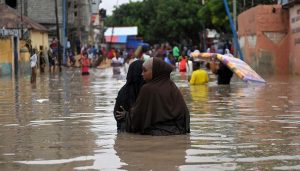Governments and the United Nations (UN) are reporting increasing numbers of deaths and displaced people after flooding caused by weeks of heavy rainfall in East Africa.

In Kenya and Somalia alone, more than 200 people have lost their lives.
The UN Office for the Coordination of Humanitarian Affairs (OCHA) reported on Wednesday that the death toll in Somalia has risen to 96, and 746,000 people have fled their towns and villages to escape the floods.
A total of two million people are thought to be affected in the country in the Horn of Africa.
The situation is also worsening in neighbouring Kenya.
Raymond Omollo, the East African country’s interior minister, spoke of at least 120 deaths at a crisis meeting on Tuesday.
In addition, people from almost 90,000 households had been housed in 120 temporary camps.
He did not provide any information on the total number of people affected.
The floods are a consequence of persistent rain associated with the El Niño weather phenomenon.
Aid organisations have already warned of an increasing number of cases of cholera and other diseases caused by stagnant water in the affected areas.
The situation is particularly bad in rural areas and urban slums without sewage systems.
In recent years, Somalia, north-eastern Kenya, and parts of Ethiopia have all been severely affected by drought.
The rainy seasons, which actually occur twice a year, have failed five times in a row.
The El Niño phenomenon, which is caused by a warming of the tropical Pacific, causes a “reversal” of the weather, with heavy rain in drought areas and drought in otherwise precipitation-rich areas.
The phenomenon is usually observed every two to seven years.
Climate researchers say global warming is intensifying.
